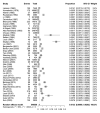How Common is Essential Tremor? Update on the Worldwide Prevalence of Essential Tremor
- PMID: 34277141
- PMCID: PMC8269764
- DOI: 10.5334/tohm.632
How Common is Essential Tremor? Update on the Worldwide Prevalence of Essential Tremor
Abstract
Background: Essential tremor (ET) is among the most prevalent movement disorders. Comprehensive reviews of disease prevalence were published in 1998 and 2010 but not since then. We reviewed the prevalence of ET in population-based epidemiological studies, derived a precise summary estimate of prevalence from these studies, and examined differences in prevalence across studies. We used two methods: a descriptive-analytical approach and a meta-analysis.
Methods: A PUBMED search yielded 14 published papers since the 2010 review.
Results: There were 42 population-based prevalence studies (23 countries and 6 continents). In a meta-analysis, pooled prevalence (all ages) = 1.33%, with statistically significant heterogeneity across studies (I2 = 99.3%, p < 0.0001). In additional descriptive analyses, median crude prevalence (all ages) = 0.4% and mean = 0.67%. Prevalence increased markedly with age, and especially with advanced age. In the meta-analysis, prevalence (age ≥ 65 years) = 5.79%, and in descriptive analyses, median crude prevalence (age ≥ 60-65) = 5.9% and mean = 8.0%. In the oldest age groups, median prevalence = 9.3%, with several studies reporting values >20%. The prevalence increased by 74% for every decade increase in age (p < 0.0001). Gender did not impact the prevalence of ET (p = 0.90).
Discussion: Precise prevalence estimates are important because they form the numerical basis for public health initiatives and offer clues about underlying biological factors of mechanistic importance. The prevalence of ET among those age ≥ 65 is similar to that reported for Alzheimer's disease in elders, suggesting that ET may be the most common neurodegenerative disease.
Keywords: Essential tremor; definition; epidemiology; prevalence.
Copyright: © 2021 The Author(s).
Conflict of interest statement
The authors have no competing interests to declare.
Figures
References
-
- Charles PD, Esper GJ, Davis TL, Maciunas RJ, Robertson D. Classification of tremor and update on treatment. Am Fam Physician. 1999; 59: 1565–1572. - PubMed
Publication types
MeSH terms
Grants and funding
LinkOut - more resources
Full Text Sources
Medical





